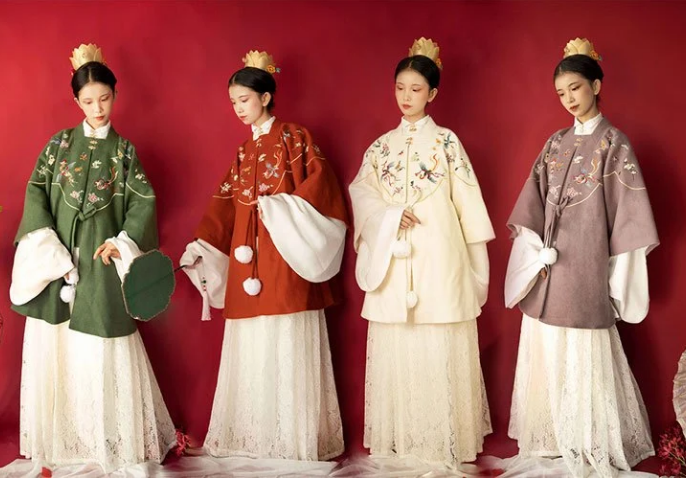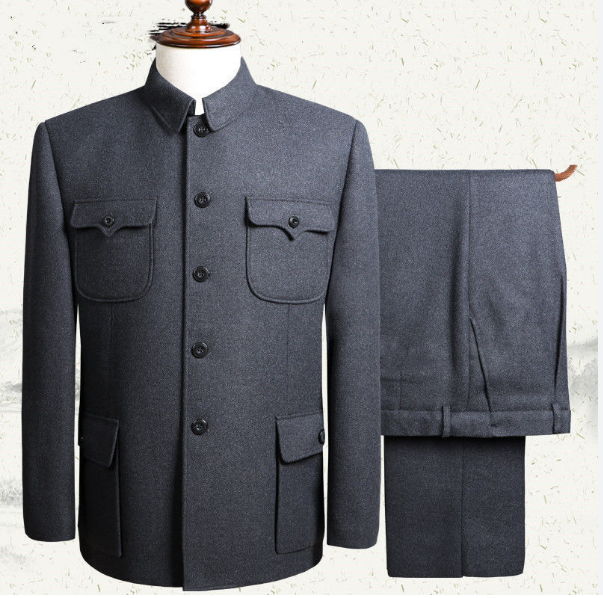The four renowned traditional Chinese clothing types are Hanfu, Qipao, Tangzhuang, and the Zhongshan Suit.
Introduction to Traditional Chinese Clothing
Traditional Chinese clothing stands as a vibrant testament to the rich cultural heritage and artistic ingenuity of China. These garments, steeped in history, showcase the intricate craftsmanship and deep philosophical underpinnings unique to Chinese culture.
Historical Significance
The evolution of traditional Chinese attire mirrors the country’s historical journey. Initially, clothing styles varied significantly across different dynasties, each reflecting the societal norms and aesthetic preferences of the era. For instance, the Han Dynasty favored the Hanfu, a flowing robe symbolizing grace and dignity. This garment has profound cultural importance, often linked to Confucian ideals of propriety and harmony. Over centuries, these styles have evolved, adapting to changes in society, yet always retaining a connection to their historical roots.

Evolution Over Time
As time progressed, Chinese fashion witnessed a blend of traditional designs with modern influences. The emergence of the Qipao (Cheongsam) in the 20th century marked a significant transition. Originally a loose-fitting dress, it evolved into a more form-fitting style, reflecting the changing societal attitudes towards women and fashion. This evolution signifies not just a change in style but also a cultural shift, as traditional clothing adapted to contemporary tastes while preserving its distinct heritage.
Throughout this evolution, the materials, designs, and techniques used in traditional Chinese clothing have continuously evolved, showcasing the adaptability and resilience of Chinese culture. Each piece, whether a silk Hanfu or an elegantly tailored Qipao, tells a story of history, art, and identity, offering a glimpse into the soul of China.
Hanfu
Hanfu, the classical clothing of the Han Chinese, stands as a symbol of China’s extensive history and rich cultural identity. This traditional attire, dating back over 3,000 years, showcases the aesthetic sensibilities and craftsmanship of ancient China.
Styles and Variations
Hanfu boasts a variety of styles, each reflecting different historical periods and social statuses. Commonly, it consists of a robe or a shirt and a skirt, often accompanied by a belt. The designs range from the simple, unadorned Yichang of commoners to the elaborate, ornate Shenyi worn by nobility. The materials used, predominantly silk and linen, further add to the garment’s elegance. Colors also play a significant role, with each hue representing different cultural meanings and social classes.
Cultural and Ceremonial Importance
Hanfu is not merely a fashion statement but also a carrier of deep cultural and ceremonial significance. It plays a crucial role in traditional festivals, weddings, and Confucian rites, symbolizing respect and adherence to cultural values. The garment’s design, adhering to the Confucian principle of harmony, reflects the balance and order valued in Chinese culture. In recent years, there has been a resurgence in wearing Hanfu, as many young Chinese seek to reconnect with their heritage, further solidifying its status as a vital link to the past.
The revival of Hanfu not only preserves traditional Chinese culture but also opens a window for the world to understand and appreciate the depth and diversity of Chinese heritage. Through Hanfu, the stories, philosophies, and artistry of ancient China continue to live on, woven into the fabric of modern life.
Qipao
The Qipao, a symbol of elegance and modernity, captures the essence of traditional Chinese fashion while embracing contemporary aesthetics. Originating in the 17th century, this iconic garment has undergone a fascinating evolution, becoming a global fashion statement.
Design and Adaptation
Initially, Qipao featured a loose, flowing design, providing comfort and modesty. However, in the 1920s, as societal attitudes shifted, the Qipao underwent a dramatic transformation. It became more form-fitting, accentuating the wearer’s figure, with high collars and slits on the side for ease of movement. The fabric choice expanded beyond silk to include a variety of materials, each adding a unique texture and feel. Modern adaptations have introduced shorter lengths and varying sleeve styles, making the Qipao versatile for different occasions.
Influence on Contemporary Fashion
The Qipao’s influence extends far beyond its cultural origins, impacting global fashion trends. Its elegant silhouette and versatility have inspired numerous designers worldwide, leading to adaptations in haute couture and ready-to-wear collections. The garment’s blend of traditional motifs and modern styles makes it a popular choice for formal events and everyday wear, reflecting a fusion of Eastern and Western fashion sensibilities.
The enduring appeal of the Qipao lies in its ability to evolve while maintaining its cultural essence. As a fashion icon, it not only represents Chinese cultural heritage but also symbolizes the dynamic nature of fashion, constantly adapting and reinventing itself in the ever-changing world of style.
Tangzhuang
Tangzhuang, a traditional Chinese jacket, represents a remarkable blend of historical elegance and contemporary style. Its resurgence in modern fashion marks a renewed interest in China’s sartorial heritage.
Historical Roots and Modern Interpretation
Tangzhuang traces its origins back to the Tang Dynasty, known for its rich cultural and artistic achievements. Traditionally, it featured a straight collar and knot buttons, symbolizing Chinese aesthetics. In recent decades, designers have reimagined Tangzhuang, infusing it with modern elements while retaining its classic essence. Today’s versions experiment with colors, fabrics, and cuts, making Tangzhuang a versatile garment suitable for various occasions, from formal events to casual outings.
Originally from the Tang Dynasty, Tangzhuang was synonymous with prosperity and cultural flourish. Key features include:
- Straight Collar: Traditional Tangzhuang has a distinctive straight collar, representing the refined fashion of the Tang Dynasty.
- Knot Buttons: The use of knot buttons is a hallmark of this garment, showcasing intricate Chinese craftsmanship.
In modern times, designers have reinterpreted Tangzhuang, while respecting its classic roots. Modern adaptations often include:
- Diverse Fabrics: Beyond the traditional silk, contemporary Tangzhuangs use a variety of fabrics, catering to different tastes and occasions.
- Updated Cuts: While maintaining the essence, the cut and fit of modern Tangzhuang have evolved to suit current fashion sensibilities.
Symbolism and Usage in Present Day
Today, Tangzhuang is more than just attire; it’s a symbol of cultural pride and unity. Its present-day usage and symbolism include:
- Cultural Celebrations: Tangzhuang is a popular choice during Chinese New Year and other cultural events, symbolizing a connection to heritage.
- International Fashion: Its unique design has gained popularity globally, bridging Eastern and Western fashion.
In contemporary culture, Tangzhuang has become a symbol of national pride and cultural identity, especially during significant events like the Chinese New Year or international gatherings. It’s not just attire but a statement of heritage and unity. This garment has also found its way into the global fashion scene, appreciated for its unique blend of tradition and modernity. The Tangzhuang’s adaptability to modern fashion trends while preserving its cultural symbolism demonstrates the enduring relevance and appeal of traditional Chinese attire in the global fashion narrative.

Zhongshan Suit
The Zhongshan suit, commonly known as the Mao suit in the West, serves as a powerful emblem of China’s political and cultural evolution. This distinctive attire, originating in the early 20th century, symbolizes China’s journey through modernization and revolution.
Origin and Historical Context
The inception of the Zhongshan suit is deeply rooted in a transformative era in Chinese history. Key aspects of its origin include:
- Inspired by Sun Yat-sen: Sun Yat-sen, a pivotal figure in overthrowing the Qing dynasty, advocated for this attire. He envisioned it as a symbol of national unity and a break from the feudal past.
- Military and Practical Design: Reflecting the utilitarian ethos of the time, the suit featured a turned-down collar and four large pockets, representing the common man’s needs and the spirit of the military.
This suit quickly transcended its initial purpose, becoming a symbol of the new China’s aspirations for progress and anti-imperialism.
Evolution and Current Relevance
Despite its early political connotations, the Zhongshan suit’s significance has evolved over time. Its contemporary relevance encompasses:
- State Occasions and Diplomacy: High-ranking Chinese officials often don this attire for significant state events and diplomatic meetings, showcasing a link to political heritage.
- Fashion and Global Influence: The suit has found a place in international fashion, with designers incorporating its elements into modern clothing lines. This trend illustrates the enduring appeal of the suit’s simplistic yet powerful design.
The Zhongshan suit, with its austere style and deep historical roots, continues to be a potent symbol of China’s cultural identity. It represents the country’s complex history, national pride, and the enduring spirit of resilience and unity.